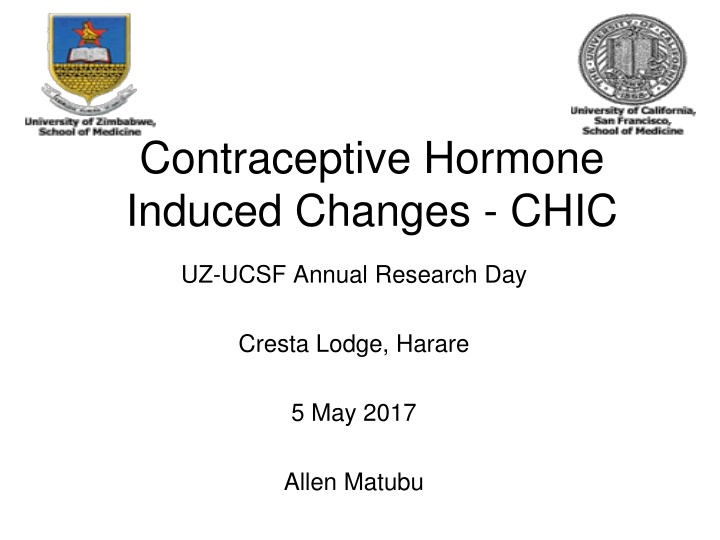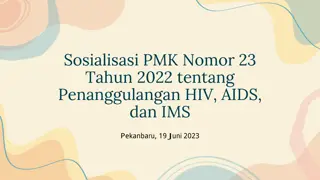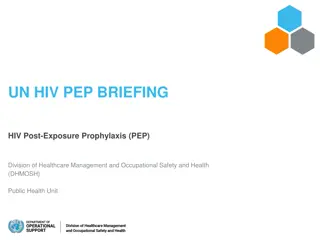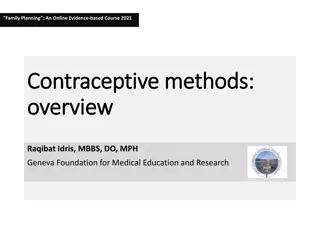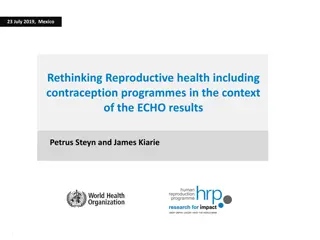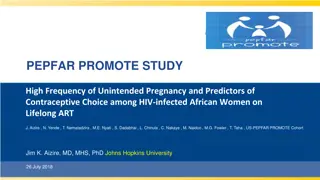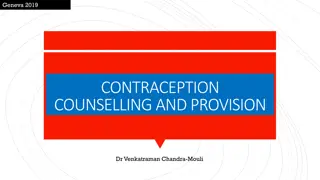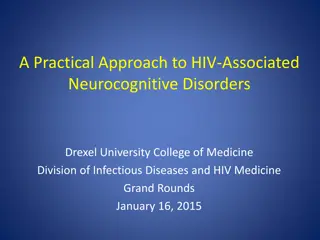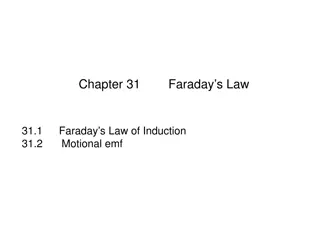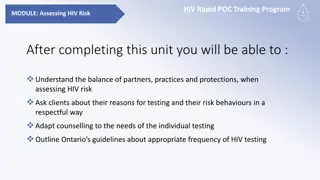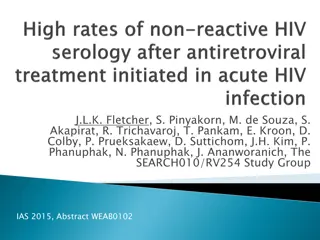Contraceptive Hormone-Induced Changes and HIV Risk Assessment
Investigating the impact of contraceptive methods on biological and immunological changes related to HIV risk in women aged 18-34 in Zimbabwe. Two approaches are being studied, including a randomized controlled trial to analyze immune cell populations before and after contraceptive use initiation. Preliminary findings suggest that Net-EN use is associated with increased HIV-target cells locally and systemically.
Download Presentation

Please find below an Image/Link to download the presentation.
The content on the website is provided AS IS for your information and personal use only. It may not be sold, licensed, or shared on other websites without obtaining consent from the author.If you encounter any issues during the download, it is possible that the publisher has removed the file from their server.
You are allowed to download the files provided on this website for personal or commercial use, subject to the condition that they are used lawfully. All files are the property of their respective owners.
The content on the website is provided AS IS for your information and personal use only. It may not be sold, licensed, or shared on other websites without obtaining consent from the author.
E N D
Presentation Transcript
Contraceptive Hormone Induced Changes - CHIC UZ-UCSF Annual Research Day Cresta Lodge, Harare 5 May 2017 Allen Matubu
Untangling the mixed data on HC-HIV Two approaches currently underway: Objective: Investigation of biological and immunological changes that occur with contraceptive use and that may impact HIV risk (CHIC Studies, Haddad, Dezzutti, etc) To assess the impact of contraceptive methods on the numbers and activation status of immune cells in the genital tract Randomized controlled trial (ECHO trial) Women randomized to DMPA, LNG implant, or copper IUD Hypothesis for ZimCHIC Study: Women initiating DMPA will have increased cervical HIV target cells compared to baseline after 3 months of use.
Zim CHIC Study Methods Women in Harare, Zimbabwe Healthy Women Ages 18-34 HIV negative Free of STIs (GC, CT, Trichomonas, active HSV) No recent exogenous hormone use (N=451 with self-report) No hormonal or intrauterine contraceptives for >30 days No DMPA for >10 months All in follicular phase of menstrual cycle (day 1-14) and not bleeding Confirmed objectively by UPLC-MS/MS at each visit (N=234) Immune cell populations from PBMCs and cervical cytobrushes were quantified by flow cytometry Baseline and 90-days following initiation of contraceptive Paired changes evaluated with Wilcoxon Signed Rank Gating independently performed by 3 masked scientists Contraception (started immediately after baseline sampling*) Injectables: DMPA, Net-EN, MPA/E2 (N=43, 41 and 36 respectively) Implants: LNG and ENG (N=36 and 37 respectively) IUD: copper (N=41) *DMPA, Net-EN and MPA/EE were administered every 90, 60 and 30 days respectively
Net-EN Use Associated with Local and Systemic Increases in HIV-Target Cells Number CD4+ CCR5+ in Cytobrush Percent CD4 Cells Expressing CCR5+ in Cytobrush CD4+ CCR5+ MFI in Cytobrush Enrollment (Day 0) 90-day follow-up Median # Cells per Cytobrush p=.02 60 2000 p<.001 3000 p=.13 p=.17 p=.002p=.11 p=.35 p=.62 p=.35 p=.08 p=.26 p=.16 p=.90 p=.94 Geometric MFI Median % Cells p=.03 1500 50 2000 p=.58 p=.45 p=.78 CD4+ CCR5+ MFI in PBMC Number CD4+ CCR5+ in PBMC Percent CD4 Cells Expressing CCR5+ in PBMC 1000 40 1000 p=.007p=.93p=.19 p=.67 8 p=.04 1500 4000 p=.01 p=.42 p=.98 p=.56 1400 p=.03 Median % Cells Geometric MFI 7 p=.99 p=.70 3500 Median # Cells p=.10 p=.80 p=.77p=.72 p=.74 1300 500 30 6 p=.17 3000 0 1200 MPA/E2 ENG implant DMPA Net-EN DMPA Copper IUD ENG implant LNG implant MPA/E2 ENG implant DMPA Copper IUD Net-EN DMPA Copper IUD ENG implant LNG implant MPA/E2 DMPA MPA/E2 Copper IUD Net-EN LNG implant ENG implant 5 2500 1100 4 1000 2000 MPA/E2 DMPA Net-EN Copper IUD LNG implant Net-EN LNG implant ENG implant MPA/E2 Copper IUD Net-EN LNG implant
Copper IUD Use Associated with Local Increases in HIV-Target Cells Number CD4+ CCR5+ in Cytobrush Percent CD11c Cells in Cytobrush Number CD11c in Cytobrush Median # Cells per Cytobrush p=.007 Median # Cells per Cytobrush p=.02 2000 100000 30 p=.21 p=.002 p=.43 p=.60 p=.32 p=.35 Enrollment (Day 0) p=.95 80000 p=.94 Median % Cells p=.03 1500 20 p=.32 p=.58 p=.84 60000 p=.67 p=.99 90-day follow-up p=.13 p=.78 40000 1000 10 20000 500 0 0 MPA/E2 DMPA Net-EN Copper IUD ENG implant LNG implant DMPA MPA/E2 Net-EN Copper IUD ENG implant LNG implant MPA/E2 DMPA Net-EN Copper IUD ENG implant LNG implant Number CD4+ CD69+ in Cytobrush Number CD4+ CCR5+ in PBMC Number CD11c in PBMC 20000 Median # Cells per Cytobrush p=.002 3000 4000 p=.01 p=.48 p=.93 p=.98 p=.39 p=.93 p=.90 p=.55 p=.56 2500 15000 Median # Cells p=.08 p=.99 3500 p=.05 Median # Cells p=.10 p=.74 p=.40 p=.24 2000 p=.86 10000 3000 1500 5000 2500 1000 0 500 2000 MPA/E2 DMPA Net-EN Copper IUD ENG implant LNG implant DMPA MPA/E2 Net-EN Copper IUD ENG implant LNG implant MPA/E2 DMPA Copper IUD Net-EN LNG implant ENG implant
Conclusions and Implications Strengths: Population of young, healthy African women Carefully defined with respect to STIs and hormone exposure Paired analyses pre and post exposure Net-EN but not MPA initiation associated with increases in: CCR5 and CD69 on CD4 lymphocytes in PBMCs and cytobrush These data suggest any increased HIV susceptibility associated with MPA may occur through an alternative mechanism Copper IUD initiation associated with increases in: CCR5 and CD69 on CD4 lymphocytes in cytobrush CD11c cells (# and %) in cytobrush IUDs should not be considered as placebos when evaluating the impact of contraceptives on HIV risk No changes in immune cells with LNG or ENG contraceptive implants
Acknowledgements ZimCHIC Participants IRBs-JREC, MRCZ, MCAZ, RCZ Sharon Achilles & Sharon Hillier Prof ZM Chirenje & Dr F Mhlanga ZimChic study Team UZ-UCSF Clinic and Lab Teams
